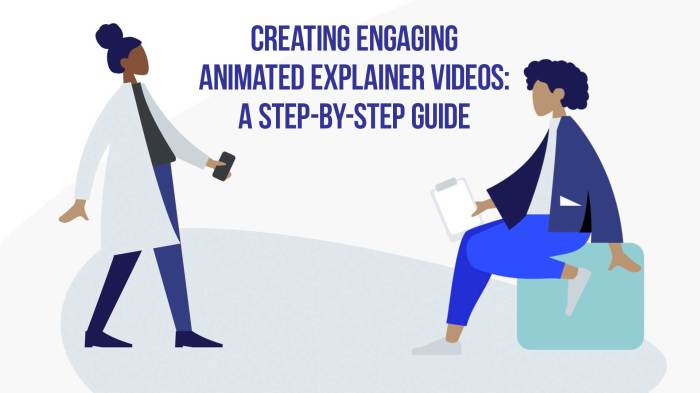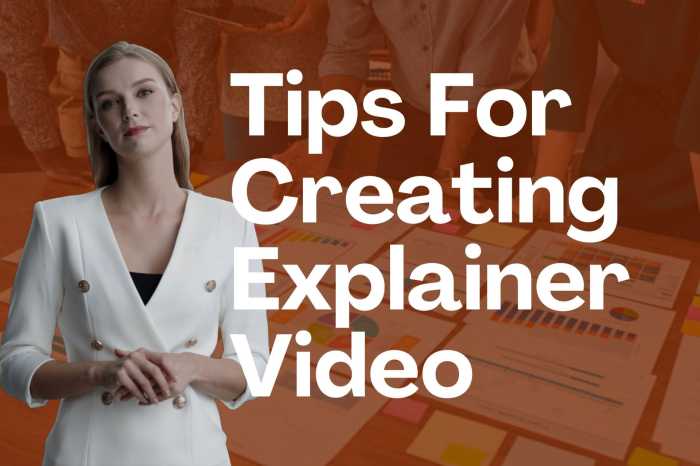Kicking off with Creating Explainer Videos, this guide will take you on a journey through the world of engaging visual storytelling. From defining explainer videos to measuring success, we’ve got you covered with all the juicy details. So buckle up and get ready to dive into the exciting realm of video creation!
Introduction to Explainer Videos

Explainer videos are short animated videos that aim to explain a concept, product, or service in a simple and engaging way. They are designed to deliver a message clearly and concisely to the audience.
Effectiveness of Explainer Videos
Explainer videos are effective in conveying messages because they combine visual and auditory elements, making the content more engaging and memorable. They can break down complex ideas into easy-to-understand visuals, making it easier for viewers to grasp the information being presented.
- They are great for capturing and maintaining the viewer’s attention.
- They can simplify complex information and make it more digestible.
- They can increase understanding and retention of key messages.
- They can boost conversion rates and drive engagement.
Industries Using Explainer Videos
Explainer videos are commonly used in various industries to communicate with their target audience effectively. Some industries that frequently use explainer videos include:
- Technology and software companies
- E-commerce businesses
- Healthcare and medical services
- Education and e-learning platforms
- Financial and banking institutions
Types of Explainer Videos
Explainer videos come in various types, each with its own unique style and approach to conveying information effectively. Let’s explore some of the most common types and their pros and cons.
Animated Explainer Videos
Animated explainer videos use colorful animations and engaging visuals to simplify complex concepts. They are versatile and can easily capture viewers’ attention. However, they can be time-consuming and costly to produce. A great example of a brand effectively using animated explainer videos is Dropbox, which used this format to explain its cloud storage services in a fun and engaging way.
Whiteboard Explainer Videos
Whiteboard explainer videos simulate the process of someone drawing on a whiteboard to explain a concept. They are simple yet effective in keeping viewers engaged. However, they may lack the visual appeal of animated videos. One brand that has successfully utilized whiteboard explainer videos is RSA Animate, known for their thought-provoking and educational content.
Live-Action Explainer Videos
Live-action explainer videos feature real people or actors to deliver a message. They can create a personal connection with viewers and add a human touch to the content. On the downside, they require more resources and planning compared to other types. Dollar Shave Club is a prime example of a brand that has leveraged live-action explainer videos to showcase its products and brand personality effectively.
Steps to Create an Explainer Video
Creating an explainer video involves several key steps that are essential for producing a high-quality and engaging video content. From scripting to selecting the right tone and style, each step plays a crucial role in the overall success of the video.
Scripting and Storyboarding, Creating Explainer Videos
Scripting and storyboarding are the foundation of any explainer video. A well-written script is vital to convey your message clearly and effectively to your audience. It should be concise, engaging, and easy to follow. Storyboarding helps visualize how the video will flow, allowing you to plan the visuals and transitions in advance.
- Write a compelling script that highlights the problem, solution, and benefits of your product or service.
- Create a storyboard to map out the visual elements of your video, including scenes, characters, and animations.
- Review and refine your script and storyboard to ensure they align with your brand voice and messaging.
Choosing the Right Tone, Style, and Length
Selecting the appropriate tone, style, and length for your explainer video is crucial in capturing the attention of your audience and delivering your message effectively.
- Determine the tone based on your target audience and the nature of your product or service. Whether it’s professional, friendly, or humorous, the tone should resonate with your viewers.
- Choose a style that complements your brand identity and enhances the overall visual appeal of the video. Whether it’s animated, live-action, or a combination of both, the style should align with your brand aesthetics.
- Decide on the length of the video based on the complexity of your message and the attention span of your audience. Ideally, keep it under two minutes to maintain engagement and convey the key points effectively.
Tools and Software for Creating Explainer Videos
When it comes to creating awesome explainer videos, having the right tools and software can make all the difference. Let’s dive into some popular options and compare their features to help you choose the best one for your project.
Popular Tools and Software
- Adobe After Effects: Known for its powerful features and flexibility, After Effects is a favorite among professionals for creating motion graphics and visual effects.
- Powtoon: Perfect for beginners, Powtoon offers an easy-to-use interface with pre-designed templates and drag-and-drop functionality.
- Explaindio: A versatile tool that combines animation, whiteboard sketch, and HD video production to create stunning explainer videos.
- Camtasia: Ideal for screen recording and editing, Camtasia is great for tutorials and software demos.
Comparing Features
- Adobe After Effects offers advanced animation capabilities but has a steeper learning curve compared to Powtoon.
- Powtoon provides ready-made templates for quick video creation, while Explaindio allows for more customization and creativity.
- Camtasia excels in screen recording and editing features, making it a top choice for tutorial videos.
Tips for Selecting the Best Tool
- Consider the complexity of your project and the level of customization required.
- Think about your budget and look for tools that offer the best value for money.
- Read reviews and watch tutorials to understand the user experience and functionality of each tool.
- Don’t forget to consider customer support and updates to ensure long-term usability of the software.
Best Practices for Creating Engaging Explainer Videos
Creating engaging explainer videos is crucial to capturing and maintaining the attention of your audience. By following best practices, you can ensure that your video effectively communicates your message and keeps viewers interested from start to finish.
Techniques for Keeping Viewers Engaged Throughout the Video
To keep viewers engaged throughout your explainer video, consider the following techniques:
- Keep it concise and to the point: Avoid unnecessary information and stick to the key message you want to deliver.
- Use storytelling: Engage viewers by telling a compelling story that captivates their attention.
- Include visuals and animations: Use eye-catching visuals and animations to enhance the overall viewing experience.
- Inject humor: Adding humor can make your video more entertaining and memorable for viewers.
- Use a conversational tone: Speak directly to the audience in a friendly and approachable manner to create a connection.
Tips on Creating Compelling Visuals and Animations
When creating visuals and animations for your explainer video, consider the following tips:
- Keep it simple: Avoid cluttering the screen with too much information and stick to a clean and minimalist design.
- Use color strategically: Choose a color scheme that reflects your brand and evokes the right emotions in your audience.
- Add movement: Incorporate dynamic animations to keep viewers engaged and visually stimulated.
- Focus on quality: Use high-quality graphics and animations to ensure a professional-looking final product.
- Match visuals to your message: Ensure that your visuals and animations complement and reinforce the message of your video.
Importance of a Strong Call-to-Action in an Explainer Video
A strong call-to-action (CTA) is essential for guiding viewers on the next steps to take after watching your explainer video. Here’s why it’s important:
- Directs viewer action: A clear CTA tells viewers what to do next, whether it’s visiting a website, making a purchase, or signing up for a service.
- Increases engagement: A compelling CTA can encourage viewers to interact with your brand and stay connected.
- Measurable results: Tracking the effectiveness of your CTA allows you to analyze the success of your video and make improvements for future content.
- Drives conversions: A well-crafted CTA can lead to higher conversion rates and ultimately help achieve your marketing goals.
Measuring Success of Explainer Videos: Creating Explainer Videos

Explainer videos are a valuable tool for businesses to communicate their message effectively. However, it is essential to measure the success of these videos to understand their impact and make necessary improvements. Here are key metrics used to measure the success of explainer videos:
Key Metrics for Measuring Success
- View Count: The total number of views the video receives can indicate its reach and popularity.
- Engagement Rate: This metric measures how actively viewers interact with the video through likes, comments, shares, and click-through rates.
- Retention Rate: The percentage of viewers who watch the video until the end can indicate its effectiveness in retaining audience attention.
- Conversion Rate: Tracking the number of viewers who take the desired action after watching the video, such as signing up for a service or making a purchase, is crucial for measuring the video’s impact on business goals.
Analyzing Viewer Engagement and Retention Rates
Understanding viewer engagement and retention rates is crucial for optimizing explainer videos. By analyzing these metrics, businesses can identify strengths and weaknesses in their videos and make necessary adjustments to improve performance. Strategies for analyzing viewer engagement and retention rates include:
Using analytics tools to track viewer behavior, such as drop-off points, click-through rates, and average watch time.
Segmenting audiences based on demographics, interests, and viewing habits to tailor videos to specific target groups.
A/B testing different video elements, such as thumbnails, titles, and calls to action, to determine which versions resonate best with viewers.
Optimizing Explainer Videos Based on Performance Data
Once businesses have analyzed viewer engagement and retention rates, they can optimize their explainer videos to enhance their effectiveness. Strategies for optimizing explainer videos based on performance data include:
- Refining video content to address viewer preferences and pain points identified through analytics.
- Improving video production quality, such as visuals, audio, and narration, to enhance viewer experience.
- Experimenting with different video formats, lengths, and styles to determine what resonates best with the target audience.
- Continuously monitoring and adjusting videos based on performance data to ensure ongoing success and engagement.